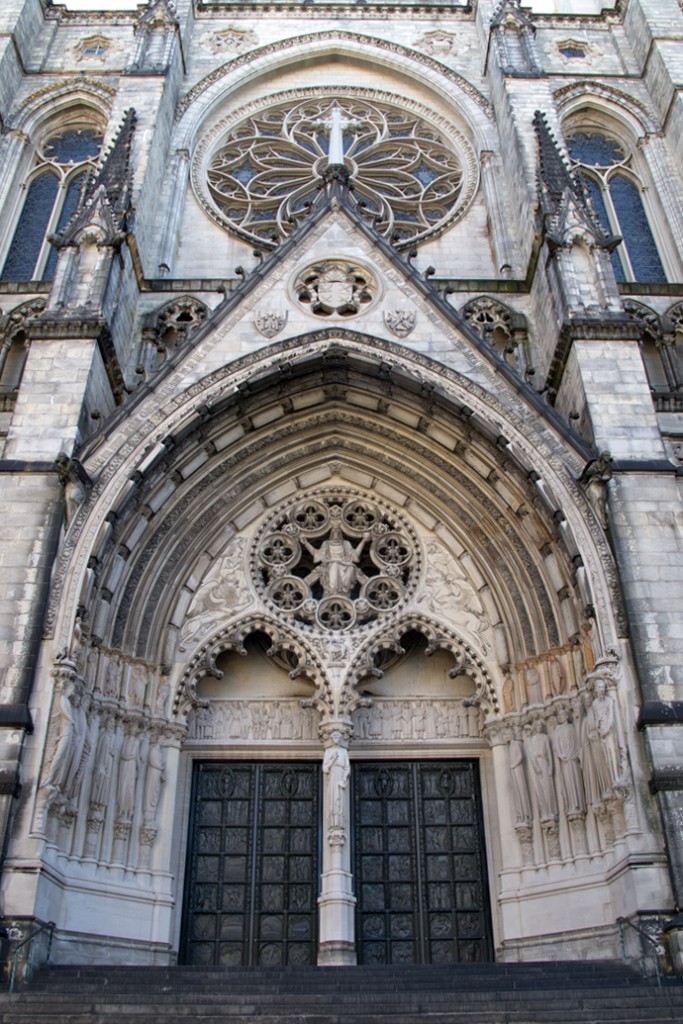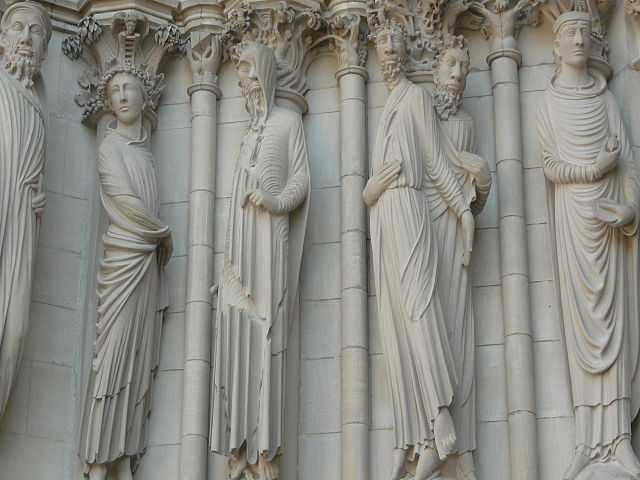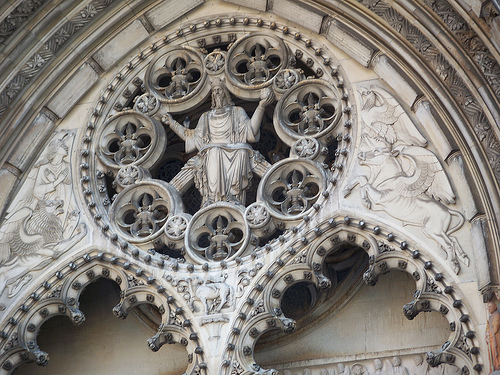Verity climbed down from the scaffold and stood with me, looking up at his work. I murmured something about how otherworldly the statue looked. “I look for something other when I carve them,” he said. “They’re not connected to this world. They’re in another place, in their heavenly robes.” I was wearing the clothes of a Brooklyn-based writer, but I was also looking for clues about how to be above this world, connected to that “something other.”
From 1988 until 1997, the British sculptor and master stone carver directed the carving of the West Portal, also known as the Portal of Passion. Assisted by six apprentices and since 1993 by Jean-Claude Marchionni, a master stone carver from France, Verity spent eight to ten hours a day, from spring until fall, up on that scaffold slowly carving a procession of thirty-two matriarchs and patriarchs from the Old and New Testaments.
 Verity explained that these holy figures lead churchgoers through the portal we are staring up at just twice a year, on Easter and in October, on the Feast of St. Francis (when elephants and a glorious parade of animals enter for blessing). The great bronze doors, also engraved with scenes from the Old and New Testaments and the Apocalypse, are called the “Easter Doors.” On Easter, church goers are guided through the portal by the biblical guides Verity carved, led in to experience the miracle of the empty tomb, the highest truth, the deathless.
Verity explained that these holy figures lead churchgoers through the portal we are staring up at just twice a year, on Easter and in October, on the Feast of St. Francis (when elephants and a glorious parade of animals enter for blessing). The great bronze doors, also engraved with scenes from the Old and New Testaments and the Apocalypse, are called the “Easter Doors.” On Easter, church goers are guided through the portal by the biblical guides Verity carved, led in to experience the miracle of the empty tomb, the highest truth, the deathless.
But Verity explained that the portal he was working on and the cathedral itself are not just a random if interesting work of architecture covered with sculpted biblical metaphors. It is all a work of sacred technology. The portal is a great funnel, drawing people into a carefully designed sacred space and sending them out again, transformed from their contact not just by words and images but by the finer energies that collected and circulated within. I made an effort to maintain a journalistic detachment, but this touched me, spoke to the secret agenda. There was a higher truth that was an actual finer energy, that could be felt, not just thought, and Verity knew it.
“In the thirteenth century people used geometry to describe God and the cosmos,” said Verity. “They understood that we’re all connected and that life is connected.” I loved visiting the cathedral. I felt as if I were under a higher order in that vaulted space, mysterious but real. I remembered the amazement in the eyes of some of the animals as they entered through the vast bronze doors on the Feast of St. Francis. Since they have senses far more sensitive and acute than our own, I wondered if animals could feel the finer vibrations of the sacred, if they can sense true goodness the way they can sense fear. I wondered if Verity could sense these vibrations. These were questions I vowed to myself not to actually ask Verity, questions that might seem naïve, or as if I was a spiritual seeker rather than a professional journalist. These were cards to be held close as I observed the man.
Handsome, with thick, wind-tangled hair threaded with silver and a friendly, self-deprecating manner, Verity wasn’t otherworldly in any obvious outer sense. He was (and is) a busy and accomplished man with work in the Victoria and Albert Museum, the American Academy in Rome, and in the private collections of the Prince of Wales, Sir Elton John, and Lord Rothschild. Yet there was something otherworldly about him, or about his calling. His very name meant Truth, and he carved in stone. I pointed this out to him, adding that he might have heard this before. He laughed with good-natured agreement, adding that he always had an interesting relationship with his name, and that it probably did influence his decision to become a contemporary version of a medieval artisan.
All the way up to the Upper West Side from Brooklyn, I had been prepared to meet a different kind of man, someone in touch with his body, working in a practical physical way, yet who was in alignment with something beyond his own experience, with a vast body of tradition. I had the idea that what he did might be close to devotion. I risked saying this, reasoning that devotion had a secular meaning as well as sacred, and Verity didn’t disagree. He felt a connection with the body of this church, with all those who helped build this vast space, with the bishops, deans, and pilgrims who worshipped here. He believed that even those who lived and worked nearby were part of the life of the cathedral.
In fact among these otherworldly beings were the faces of friends and neighbors of the Cathedral. Verity’s friend Naomi became the face of the Old Testament Naomi. A Tibetan woman in exile became the face of Hagar, while a member of the Cathedral staff and the owner of the Hungarian Pastry shop, the coffee shop across the street, became Jonah and Simeon. This made sense to me listening to Verity talk, especially after we crossed Amsterdam Avenue to the Hungarian Pastry shop to buy coffee. There among the clusters of students and other locals sat Verity’s stone carving partner, Jean-Claude Marchionni, who smiled and shook my hand. But it also made sense to me as a seeker of the sacred. The same presence or energy or power that transformed those lives might transform mine.
Verity and I settled on a bench near a biblical garden, looking up at the gigantic Gothic revival cathedral, contending with Liverpool Anglican Cathedral for the title of largest cathedral in the Anglican Church, the fourth largest Christian church in the world. St. John the Divine is a sacred space, Verity explained. Just as in medieval cathedrals, the proportions are intended to fill us with a sense of the presence of God.
I wanted to feel this presence. I had traveled here on one of those stirring blue-sky autumn days in New York when everything seems to be illuminated, beautiful, charged with impending change. It was 1994, in the middle of decade of prosperity and innovation. I was a mother, a wife, a writer, living in a brownstone on a tree lined street in Brooklyn, all seemingly solid and fortunate things. But I knew there was a heartbreak in the center of life. That day there were changing leaves edged with golden light, excited baby-faced students wearing bright new Columbia University sweatshirts—and no escaping the knowledge that life was fleeting, impermanent. Nothing stayed. “When people came together to build these extraordinary structures, there was a sense of everybody coming together for a common purpose,” said Verity, who received some of his training at the beautiful medieval Wells Cathedral in England. “People were building blocks in a greater whole, and individual egos weren’t so important. What I’m trying is part of this medieval tradition—working with a sense that we’re all connected in a unified whole.”
Verity spoke of how much he learned from the extraordinary people who visited the cathedral—just recently he had heard an amazing talk on the universe by the cosmologist Brian Swimme. A shadow passed over the garden as the sun slipped away. I sipped the hot coffee against the chill, liking Verity’s easy openness and unpretentiousness yet disappointed with our talk, with myself, realizing that what I was seeking might not be found in any words he could say but in the quality of concentration I glimpsed in him as he worked on the scaffold.
“A real teacher teaches with his back.” I heard this from a wise old painter and author I once interviewed, not far from where Verity and I sat. The old man heard it from a Zen master in a monastery in Japan, just after the last world war. I pictured the Japanese master walking upright and serene through a country devastated by war, demonstrating an inner stillness and steadfastness that didn’t depend on what the Buddhists call “the eight worldly winds”—gain and loss, pleasure and pain, praise and blame, fame and disrepute, the up and down way things go. On his face, I envisioned gravitas and grace, the qualities Verity carved in the faces on the portal.
I wanted to know what Verity clearly seemed to understand in his body, with his hands, how to connect with a greater wholeness, how to be in alignment with something changeless, beyond the rush of life that carries us along like leaves on a stream. My secret mission had to do with gathering clues about how to be more alive. I asked Verity if he actively felt a connection with a greater presence while he worked—not just thought about it but actually felt it.
“I’ve had moments of real connection with my work,” said Verity. “I feel as if a spark has leapt and then it’s gone. These moments aren’t continuous. I keep trying to get more of a flow, to allow more without trying to control so much. How can we extend these moments of connection? That’s the question and that’s what’s so painful. You have the sense of this opening, this other energy passing through, and it’s utter bliss when it happens, but it’s transitory. I think this is what any artist is searching for. What drives you on is that it’s there and it’s just a question of getting out of the way. “
In the same way that meditators use the breath as an anchor of attention, he drew his attention to two square inches of limestone. “There’s something in the repetitive action of the work, “he said. “I’m hitting that stone once every second for two hours, and then I stop work for twenty minutes, and then I begin again, and for eight or ten hours a day, that’s what I do. That’s extraordinary, isn’t it? And I’ve been doing that for thirty years. And that’s a very strange thing to be doing.”
Life rushed on, but I never forgot what Simon Verity said about repeatedly hitting the stone. It took a long time for the true import to seep in, as if I was made of stone—and I was, in a way. As one inclined to big sweeping answers, to searching with my mind but not my body, the admission by this creator of otherworldly statues that he created them by bringing his attention down to small, simple, finite actions rang true, and like many true things it was hard to process, a code I had to learn to break on my own.
In 2004 Verity was commissioned to design and build a hand-carved map of the United Kingdom as part of the British Memorial Garden in New York’s Hanover Square, commemorating the sixty-seven British victims of the September 11, 2001, attack on the World Trade Center. In the wake of this horrific evidence of the impermanence and unpredictability of life, many New Yorkers discovered a version of Verity’s truth.
Collectively for a time, people in the city practiced that small but momentous change, pulling the attention out of our usual state of distraction and bringing it to the present moment, to the sensation of being here, meeting other eyes and opening doors. We discovered it opened up everything. In that simple act, we invited the outside world in, the better angels of our nature, God. Time passed and people forgot, including me, but when I meditated or walked in the morning, I remembered. This is how you can feel connected to a larger life: focus on one finite task, two square inches of granite, one conscious breath, and you open to the infinite, to reality.
Very slowly over many years, I learned that consenting to be with what is, body, heart, and mind, without judging or seeking to change anything in any way, allows a new energy or vibration or feeling of life to appear—and this is the truth I was searching for. This truth can be found only in the moment. One moment we are fully embodied beings, sensing and feeling the world around us and inside us, opening to perceptions of reality that lead us towards a living unknown. The next moment, we contract into thought, into stories about who we are and what the world is like, splitting off from the whole to claim our little portion of the life force as our own. But from earliest childhood, that same energy in us seeks the greater energy, seeks to be part of the greater whole.
I slowly came to accept that the drama of being a self and being no self plays out over and over again without end. I remembered it happening from earliest childhood. I remembered one day in particular, a day that ultimately may have inspired me to seek Verity and the cathedral. Johnny and Joey, the boys from next door, rolled around in the ruins of my snow fort, oblivious to the devastation they wrought. Writhing around in shiny dark snowsuits with the hoods drawn up tight, barking and diving into each other, they seemed more like seals than humans. Suddenly and passionately, I knew who I was: I was not like them.
As a child I didn’t think in terms like “ego” or “self,” but I knew the reality behind the labels. I knew the act of contraction, as if a fist were closing around a jewel, as if gates were drawing closed to protect a town, as if I were armoring myself against the world. One moment, I was being alive in the world, enjoying the hush and blue light inside my burrow, marveling how warm snow could be. The next moment I was crushed under stinging snow, then lying exposed and stunned under ice-colored sky. I was hurt, furious, but then suddenly sure I was not like them. One moment there was no self and then suddenly there was.
I remember going inside to play, to nurse and elaborate my sense of being special and not like Johnny and Joey. I padded around the living room in bare feet, pretending I was a princess in a primordial forest in India. The sense of self is born of contrast, and the living room after the snow felt like a jungle. I believed that I was not just an Indian princess in ancient times but also, inexplicably, an international spy who were summoned to various world capitals on a moment’s notice. The sense of being a spy, of having a secret aim and identity, was both a product of the Cold War times I grew up in, and an expression of an instinct that life could be deeper and richer and more meaningful. This was an instinct and a wish that would persist.
Children use their bodies, the whole of their sensate experience, along with their imaginations, to experience the world. The world is alive to them, full of surprising possibilities. But children are also engaged in that other drama. From the outside, I might have looked like an ordinary little white girl creeping around the living room of a brick ranch house in northern New York, in the depths of winter. But I also sensed there was a life inside that was deep and wild and powerful, and connected to something vast. Like most children, I secretly sensed I was capable of very great efforts and deeds, like say, carving otherworldly statues on great cathedrals. It would take me years, decades, to realize that connecting my energy with a greater energy came down to a simple repetitive action like being present and striking stone.
Later that day, I was taken skiing at a local hill, no doubt to stop me from climbing over the furniture talking to an invisible animal in what I hoped was a regal Indian accent. I loved the solitude of skiing, the way it let me be alone with what I preferred to think of as a mountain. I remember resting on my ski poles on top of the hill. The air had the cold metallic smell of coming snow. The sky was heavy with bruise-colored snow clouds, giving everything the hushed intimacy of a cathedral. Just for a moment, I felt that I was part of something exalted and marvelous.
I knew I was in a world that was vast and mysterious, but there was an order. I knew I did not know enough, that I needed to know more.
It would be many years before I discovered that what I needed to know was not to be found in some singular and extreme act of bravery or brilliance, but in the small repeated act of coming back to the present moment, letting go of who I think I am. As the stone carver Simon Verity told me, a connection with the infinite can appear in the midst of attending to something very finite. It can feel like doors swinging open, even like great bronze Easter Doors, allowing us to sense and feel how good it is to be here, creating a spark that can leap, as Verity said, a wish to join a greater good.


